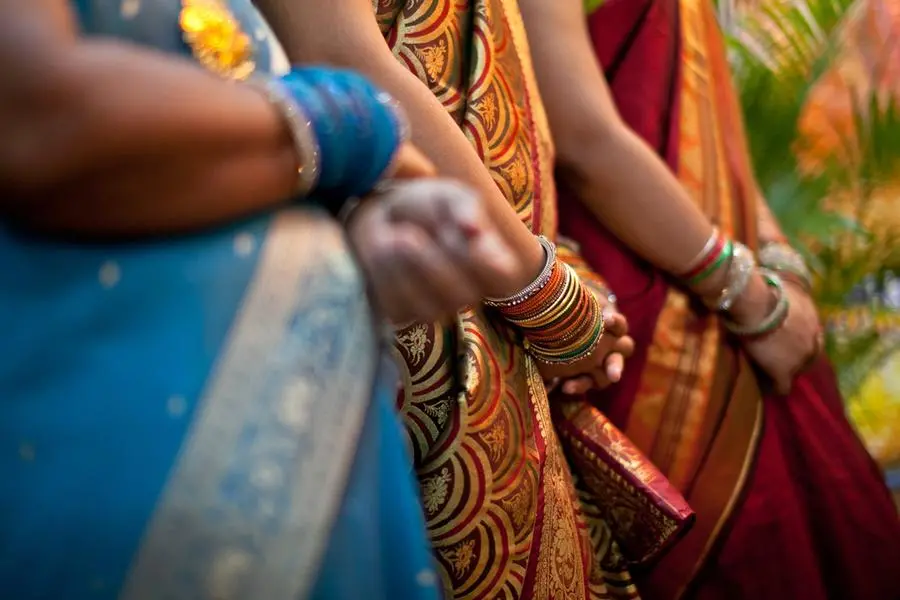PHOTO
It is a piece of history, culture and identity all wrapped in nine or six yards. The sari, a seamless garment, has travelled from the Indus Valley civilization of 3,200 BC to 2,000 BC, to the present. The word sari comes from the Sanskrit word “strip of cloth”. The sari, in itself, has undergone little change over centuries. It remains essentially an unstitched rectangular garment which is wrapped around by women. But blouses and petticoats are worn with it; the concept of a blouse evolving with the British and their prudish sensibilities.
Today, the sari is a symbol of pride and its different weaves a source of historical context about the place from where it originates. The rich Benarsi saris and their Zari (gold or silver thread work) add glitz and glamour to any occasion. The Chanderi sari, from the state of Madhya Pradesh, is a mix of cotton and silk and very popular these days. They are easy to wear and perfect for an all day wear. The Jamdani, which originally originated in Bangladesh, and is now weaved lovingly in West Bengal, lends grace to the wearer. The list goes on.
Almost every state in India has its own version of the sari and many Indian women have been on a mission to buy at least one sari from every state. No mean feat as it means picking up 28 exquisites saris that represent Gujarat to Rajasthan in your wardrobe (it is estimated that there are 30 regional varieties of saris).
It is quite a feat that the sari has survived all these centuries of change in fashion and style. I would give much credit to some of the new designers who through their creativity have given the traditional sari a more modern, fun look. For me personally, that designer was Satya Paul. The vibrant, rich colours and the designs gave the traditional drape a bohemian feel that it clicked with many young women who wanted a mix of the traditional and modern. Of course, Sanjay Garg (Raw Mango) and Sabyasachi have brought the limelight back to this humble yet timeless garment. A simple cotton sari can be bought for a few hundred rupees while the Benarsi can cost a several thousands.
Politically, the sari has also been used by women politicians to send subtle messages. Indira Gandhi was regarded as a connoisseur of the handloom sari. But she wore a wide range of saris from Ikats to Parsi garas to printed cottons and more. The messaging was clear: it was one of strength and power while gracefully accepting her gender in a patriarchal, political set up. Today, the sari is used as a powerful symbol by politicians like West Bengal Chief Minister Mamata Banerjee. Her simple white cotton sari with a narrow monochrome border is her message of a simple life and her connect with the masses.
Of late the Indian government government has also tried to popularize not just the sari, the handloom version specifically. The idea now is to get weavers from different parts of the country to a common place like Delhi where people can purchase directly from the weaver. Since 2015, August 7 has been declared the National Handloom Day and two years back, on National Handloom Day, Textiles Minister Smriti Irani tweeted a picture of herself in a handloom sari, triggering a response from many Bollywood actresses like Priyanka Chopra and Neena Gupta who then shared pictures of themselves in beautiful handloom saris.
Bollywood has also played a critical role in the story of the sari over the years. The beautiful, traditional saris of black and white movies depicted naive heroines. Then came Mumtaz in the late 60s, in a form-fitting orange sari and the nation never quite recovered from the effect. It gave rise to the sari gown, a sensual make over which continues till date. Later in the 80s it was Sridevi who made the chiffon sari a must-have for every Indian woman. Even today, Bollywood is one of the best ambassadors for the six-yard wonder. The love of the sari is also quite obvious in Bangladesh, Pakistan and other South Asian countries but it remains quintessentially an Indian garment.
What makes the sari a wonder garment is that it lends itself to the female form. It doesn’t ask questions of the shape and size of the wearer, but quietly drapes around and liberates a woman. No buttons, zippers or stitches, as this piece of cloth accepts each woman’s individual spirit. T
he weaves, the colors, the simple cottons and the rich Kanchipuram saris all speak of an occasion and a mood. The sari then is the ultimate ode to the feminine spirit as it embraces her without asking any questions.
- The writer is a senior journalist based in Delhi.
Copyright © 2022 Khaleej Times. All Rights Reserved. Provided by SyndiGate Media Inc. (Syndigate.info).




















